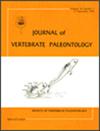来自德克萨斯州刘易斯维尔组(Cenomanian中期)的第一种小型鸟脚类恐龙。本文引用:Tykoski, R. S., Contreras, D. L., &;Noto, C.(2023)发现德克萨斯州刘易斯维尔组(Cenomanian中期)的第一只小体型鸟脚类恐龙。古脊椎动物杂志。https://doi.org/10.1080/02724634.2023.2257238
IF 1.9
4区 地球科学
Q2 PALEONTOLOGY
引用次数: 0
摘要
德克萨斯州东北部暴露的Woodbine群沉积物是在早、中期西诺曼期内陆海道退行期间沿阿巴拉契亚西南边缘沉积的一系列近岸、岸线、远端低地沼泽、湖泊和河流沉积物。德克萨斯州北部的刘易斯维尔组(上伍德拜组)保存了阿巴拉契亚地区已知的最多样化的陆生化石组合,但其中明显没有小型鸟臀目恐龙的遗骸。Lewisville组的一具几乎完整的左齿状化石代表了一种新的小型鸟脚亚目类群Ampelognathus coheni gen. et sp. 11 .,其齿状化石与Hypsilophodon、Changchunsaurus、Haya和Convolosaurus等非禽脚亚目鸟脚亚目动物的齿状化石大致相似。Ampelognathus占据了阿巴拉契亚西南部“白垩纪中期”陆生动物群中一个预期但之前缺失的组成部分。随着脊椎动物化石多样性的增加和刘易斯维尔组古植物学研究的更新,该单元的化石记录对于了解晚白垩纪早期重要过渡时期北美东部陆地生态系统的重要性得到了加强。http://zoobank.org/urn:lsid:zoobank.org:pub:02642649-ED6F-483A-994A-EC5F3FDF2AC7本文章由计算机程序翻译,如有差异,请以英文原文为准。
The first small-bodied ornithopod dinosaur from the Lewisville Formation (middle Cenomanian) of TexasCitation for this article: Tykoski, R. S., Contreras, D. L., & Noto, C. (2023) The first small-bodied ornithopod dinosaur from the Lewisville Formation (middle Cenomanian) of Texas. Journal of Vertebrate Paleontology . https://doi.org/10.1080/02724634.2023.2257238
Sediments of the Woodbine Group exposed in northeastern Texas were deposited along the southwestern margin of Appalachia as a series of near-shore, shoreline, distal lowland swamp, lake, and fluvial deposits during a regression of the Western Interior Seaway in early and middle Cenomanian time. The Lewisville Formation (upper Woodbine Group) of north Texas preserves the most diverse terrestrial fossil assemblage known from Appalachia, but remains of small ornithischian dinosaurs have been conspicuously absent from it. An almost complete left dentary from the Lewisville Formation represents a new, small-bodied ornithopod taxon, Ampelognathus coheni gen. et sp. nov. The dentary is generally similar to those in non-iguanodontian ornithopods such as Hypsilophodon, Changchunsaurus, Haya, and Convolosaurus. Ampelognathus occupied an expected but previously missing component of the ‘mid’ Cretaceous terrestrial fauna of southwestern Appalachia. The growing diversity of fossil vertebrates and renewed paleobotanical study in the Lewisville Formation reinforces the importance of the unit’s fossil record for understanding eastern North American terrestrial ecosystems during an important transitional period in the earliest Late Cretaceous.http://zoobank.org/urn:lsid:zoobank.org:pub:02642649-ED6F-483A-994A-EC5F3FDF2AC7
求助全文
通过发布文献求助,成功后即可免费获取论文全文。
去求助
来源期刊
CiteScore
2.90
自引率
7.10%
发文量
58
审稿时长
4-8 weeks
期刊介绍:
The Journal of Vertebrate Paleontology publishes original contributions on all aspects of vertebrate paleobiology, including vertebrate origins, evolution, functional morphology, taxonomy, biostratigraphy, phylogenetics, paleoecology, paleobiogeography, and paleoanthropology. JVP publishes high quality peer-reviewed original articles, occasional reviews, and interdisciplinary papers. It is international in scope, and emphasizes both specimen- and field-based based research and the use of high-quality illustrations. Priority is given to articles dealing with topics of broad interest to the entire vertebrate paleontology community and to high-impact specialist studies. Articles dealing with narrower topics, including notes on taxonomic name changes (unless these deal with errors published in JVP), preliminary site reports, and documentation of new specimens of well-known taxa, are afforded lower priority.

 求助内容:
求助内容: 应助结果提醒方式:
应助结果提醒方式:


